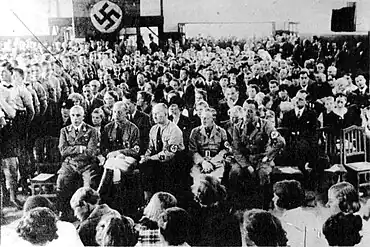
| Part of a series on |
| Nazism |
|---|
|
Nazism in Chile formally occurred via the 1930s National Socialist Movement of Chile, with later movements following over subsequent decades.
National politics
The National Socialist Movement of Chile (MNSCH) was founded in 1932. After it was dissolved in 1938, some of its notable former members migrated into the Agrarian Labor Party, obtaining high charges.[2] Other former MNSCH members formed new parties of that kind until 1952.[2]
A new Nazi Party was formed in 1964 by school teacher Franz Pfeiffer;[2] it organized a Miss Nazi beauty contest and formed a Chilean branch of the Ku Klux Klan[2] before disbanding in 1970. Pfeiffer attempted to reboot the party in 1983 amid a wave of protests against the military dictatorship of Augusto Pinochet.[2]
Nazism had also detractors in Chile. An example of this is the telegram sent by Salvador Allende and other members of the Congress of Chile to Adolf Hitler after the Kristallnacht (1938) in which they denounced the persecution of Jews.[3]
German Chilean community
Even before the Nazi takeover of Germany in 1933 there was a German Chilean youth organization with strong Nazi influence. Nazi Germany pursued a policy of Nazification of the German Chilean community.[4] These communities and their organizations were considered a cornerstone to extend the Nazi ideology across the world by Nazi Germany. It is widely known that, though there were discrepancies, most German Chileans were passive supporters of Nazi Germany. Nazism was widespread among the German Lutheran Church hierarchy in Chile. A local chapter of the Nazi Party was started in Chile.[4]
While Nazi Germany did pursue a policy of nazification of overseas German communities[5] the German community in Chile did not act as an extension of the German state to any significant degree.[6]
Racial ideologies
Nicolás Palacios considered the "Chilean race" to be a mix of two bellicose master races: the Visigoths of Spain and the Mapuche (Araucanians) of Chile.[7] Palacios traces the origins of the Spanish component of the "Chilean race" to the coast of the Baltic Sea, specifically to Götaland in Sweden,[7] one of the supposed homelands of the Goths. Palacios claimed that both the blonde-haired and the bronze-coloured Chilean Mestizo share a "moral physonomy" and a masculine psychology.[8] He opposed immigration from Southern Europe, and argued that Mestizos who are derived from Southern Europeans lack "cerebral control" and are a social load.[9]
Colonia Dignidad
See also
References
- ↑ "Hitler Youth Hiking". Facing History & Ourselves. 2022-06-28. Retrieved 2023-11-04.
- 1 2 3 4 5 Etchepare, Jaime Antonio; Stewart, Hamish I. (1995), "Nazism in Chile: A Particular Type of Fascism in South America", Journal of Contemporary History, 30 (4): 577–605, doi:10.1177/002200949503000402, S2CID 154230676
- ↑ "Telegram protesting against the persecution of Jews in Germany" (PDF) (in Spanish). El Clarín de Chile's.
- 1 2 Nocera, Raffaele (2005), "Ruptura con el Eje y el alineamiento con Estados Unidos. Chile durante la Segunda Guerra Mundial", Historia (in Spanish), 38 (2): 397–444
- ↑ Paula, Rogério Henrique Cardoso de (2017). "As comunidades alemãs frente ao nazismo no Brasil e noChile: uma História comparada" [The germans communities against nazism in the Chile and in the Brazil: comparative History]. Revista Trilhas da História (in Portuguese). 5 (10): 72–93. Retrieved February 19, 2019.
- ↑ Penny, H. Glenn (2017). "Material Connections: German Schools, Things, and Soft Power in Argentina and Chile from the 1880s through the Interwar Period". Comparative Studies in Society and History. 59 (3): 519–549. doi:10.1017/S0010417517000159. S2CID 149372568. Retrieved December 13, 2018.
- 1 2 Palacios 1918, p. 35-36
- ↑ Palacios 1918, p. 37
- ↑ Palacios 1918, p. 41
- ↑ Brown, Stephen (May 7, 2012). "Insight: German sect victims seek escape from Chilean nightmare past". Reuters.
- ↑ Rotella, Sebatian (1997-06-25). "Siege may force colony to yield its secrets". Los Angeles Times. Retrieved 2022-07-24.
- ↑ Hevia Jordán, Evelyn (2022). "Colonia Dignidad: Lights and Shadows in the Recognition of the Victims". In Elizabeth Lira; Marcela Cornejo; Germán Morales (eds.). Human Rights Violations in Latin America. Peace Psychology Book Series. Cham: Springer International Publishing. pp. 223–236. doi:10.1007/978-3-030-97542-5_16. ISBN 9783030975418. Retrieved 2022-07-24.
Bibliography
- Palacios, Nicolás (1918), Raza Chilena (in Spanish), Editorial Chilena